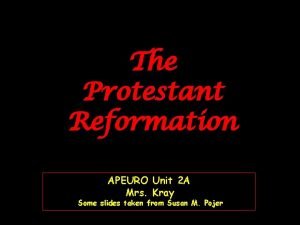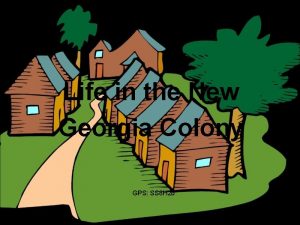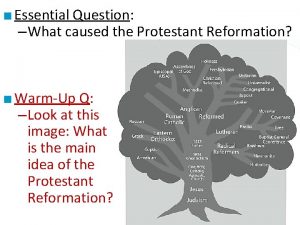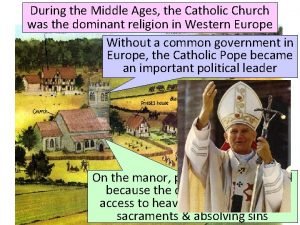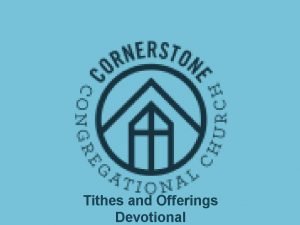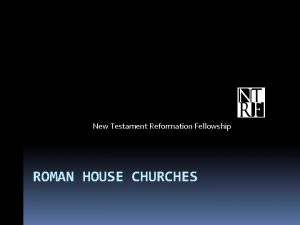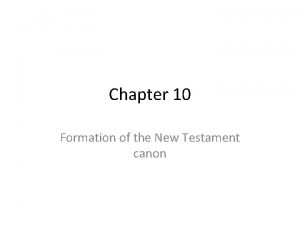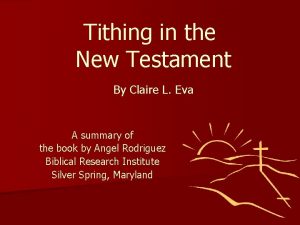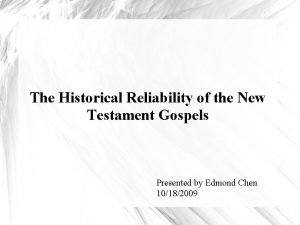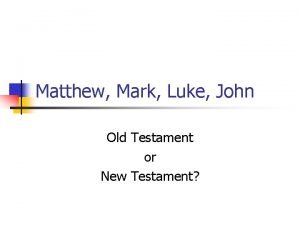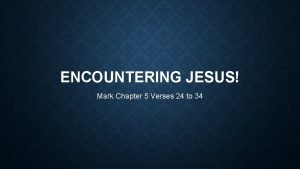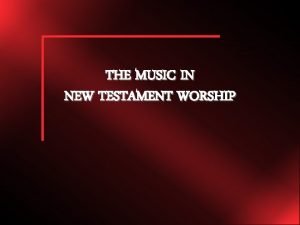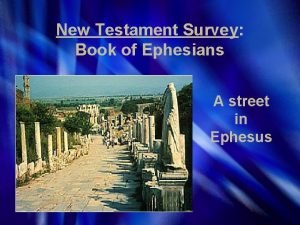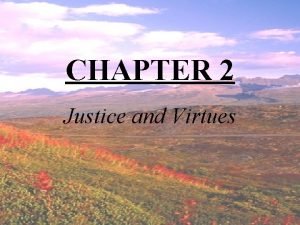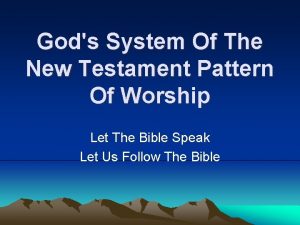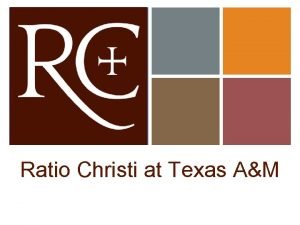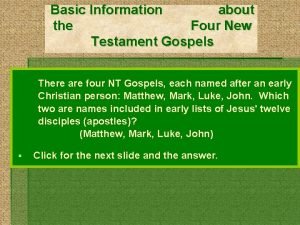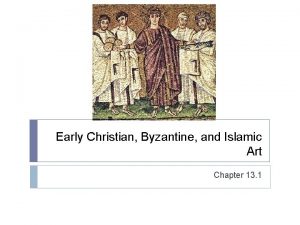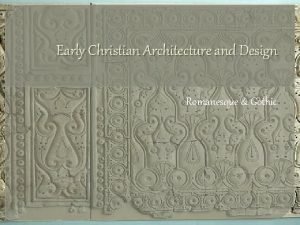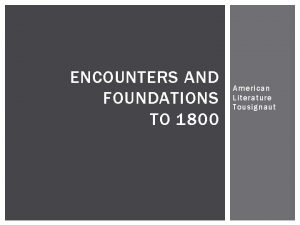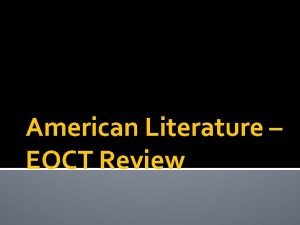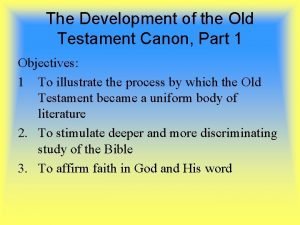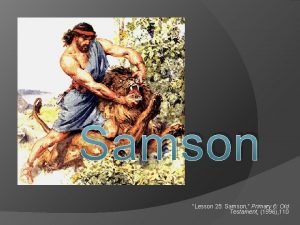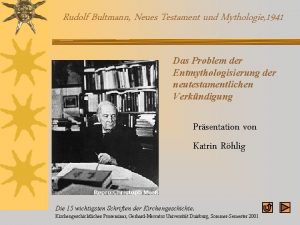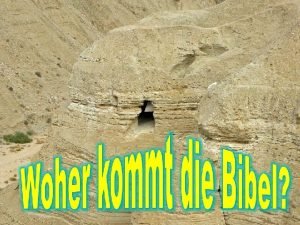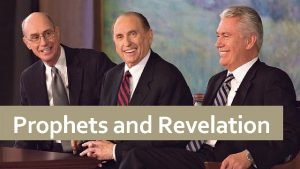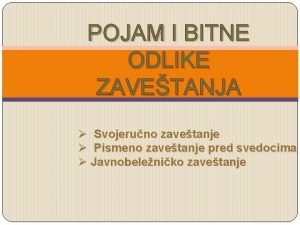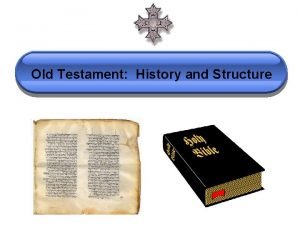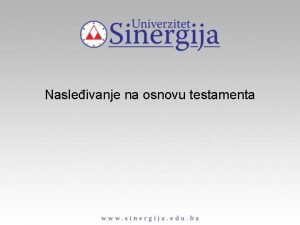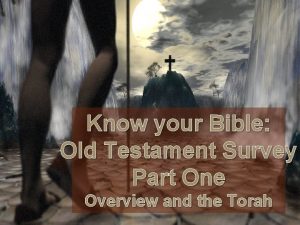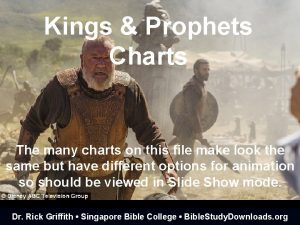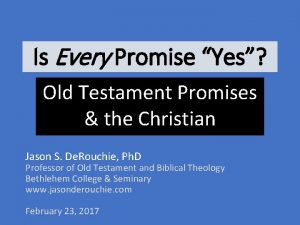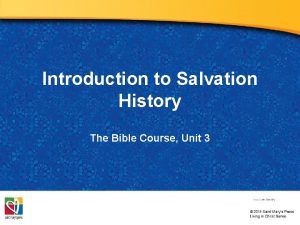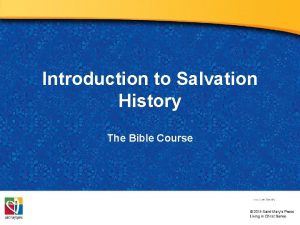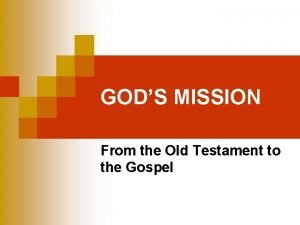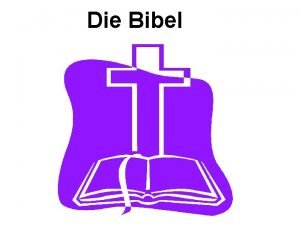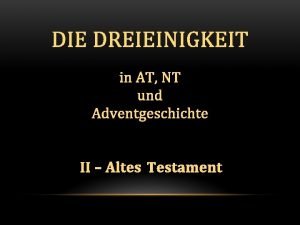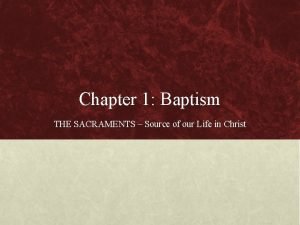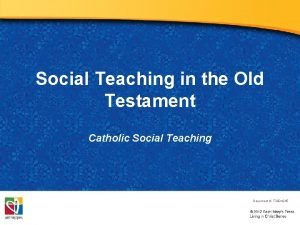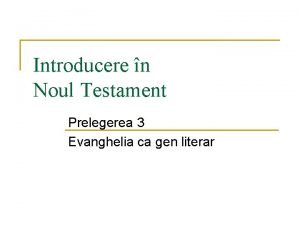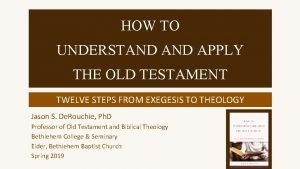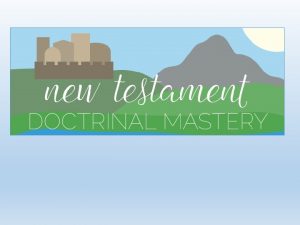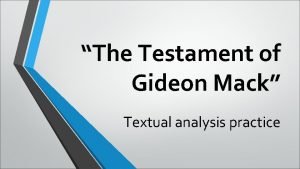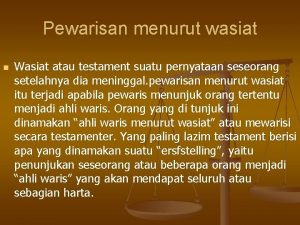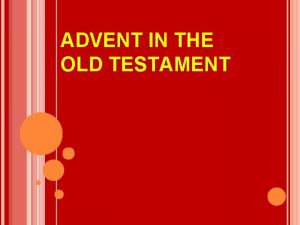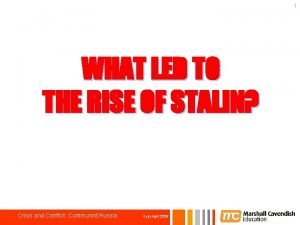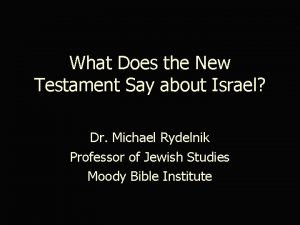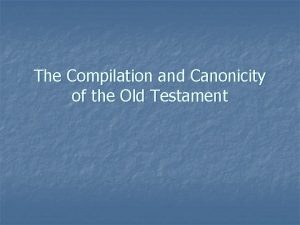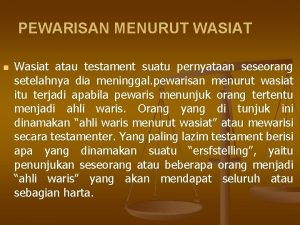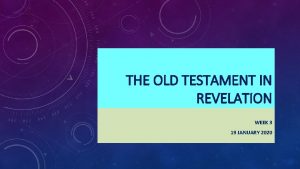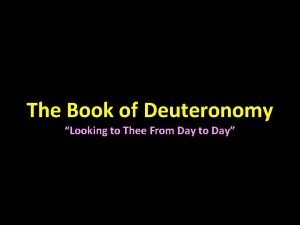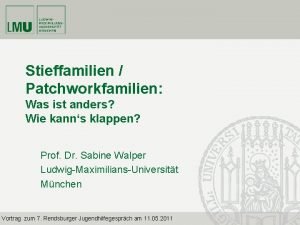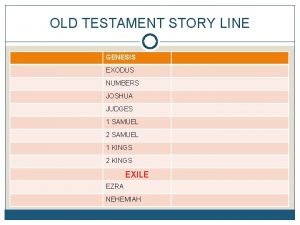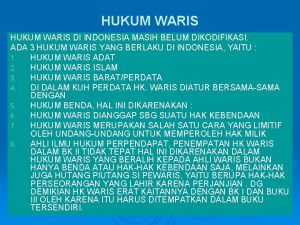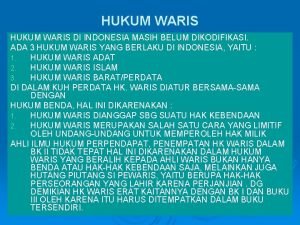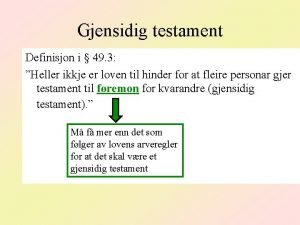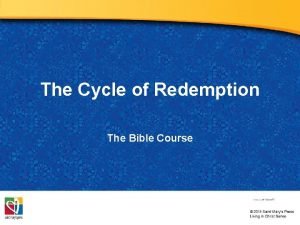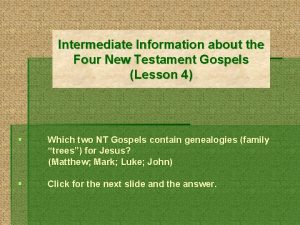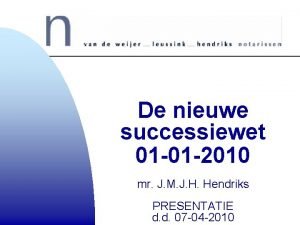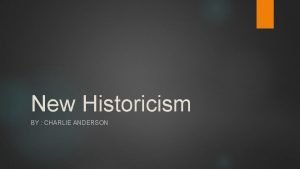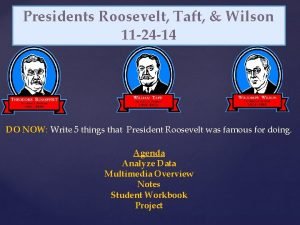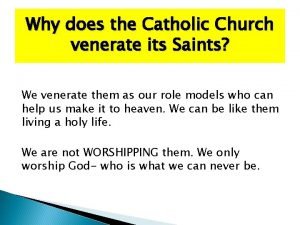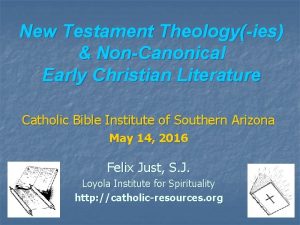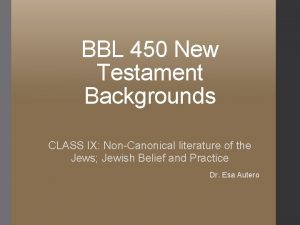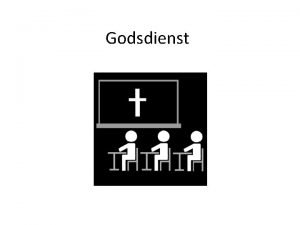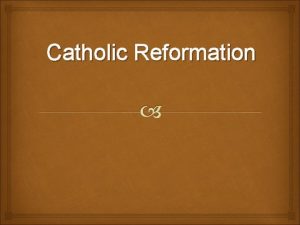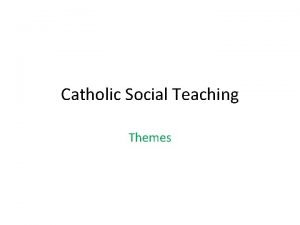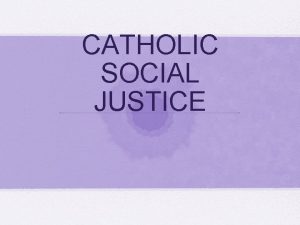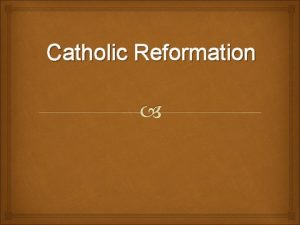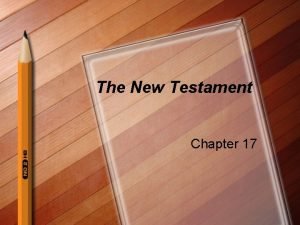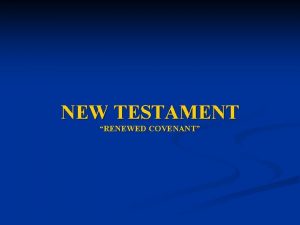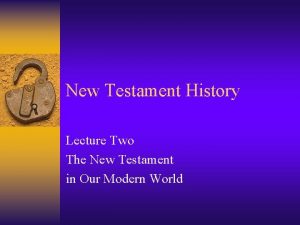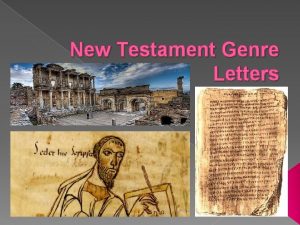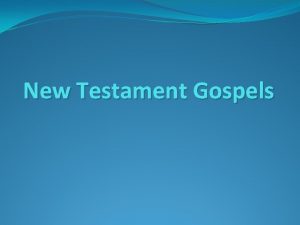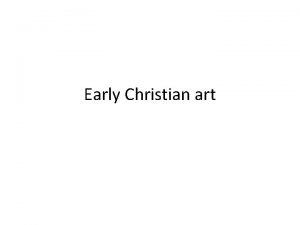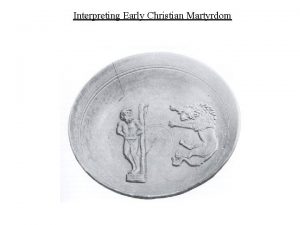New Testament Theologyies NonCanonical Early Christian Literature Catholic




















































































![Gospel of Judas (Scene 1) n n 85 … Judas [said] to him, “I Gospel of Judas (Scene 1) n n 85 … Judas [said] to him, “I](https://slidetodoc.com/presentation_image_h/b4d6c795921ade76aebc6b580cd0f334/image-85.jpg)




















- Slides: 105

New Testament Theology(-ies) & Non-Canonical Early Christian Literature Catholic Bible Institute in the Diocese of Orange June 3, 2017 Felix Just, S. J. Loyola Institute for Spirituality http: //catholic-resources. org

Opening Prayer – Martha Group n Song: Veni Sancte Spiritus n Reading: Acts 2: 1 -4 n Responsorial: Ps 104 n Intentions n Reading: De Spiritu Sancto, Basil the Great n Closing Prayer n Song: Veni Sancte Spiritus 2

Announcements n SJC Spirituality Center Open House n Today! n Summer n Randy during Lunch Break 2017: IPM Courses Lopez: Matthew; Bible & Mass n Upcoming n Pauline n Holy n Sale 3 Pilgrimages: Greece: Oct. 2018 Land: late May 2019 on “Lectionary” CD set

CBI – Year 2 – Old Testament n Instructors: Prof. Jina Kang & Dr. Daniel Smith-Christopher n n Fall 2017: Sept. 16 n n Theological Studies, Loyola Marymount University new student orientation: Aug. 26 Textbooks: n D. Smith-Christopher, The Old Testament: Our Call to Faith & Justice. Ave Maria Press, 2013. n Opt: J. Collins, Short Intro to the Hebrew Bible. 4

I) New Testament Theology/-ies n Brief Table-Group Discussions: n Is there a “main/overall message” in the N. T. ? What is it? n Is there an overall message of the Whole Bible? n “The 5 Bible says…” ?

What IS Theology? n Theos = God n n Logos = ? ? ? n n Word, phrase, sentence, expression, speech, logic, thinking, study of… John 1: 1 n 6 pl. theioi = gods “In the beginning was the logos, and the logos was with theos, and the logos was theos.

Biblical Theology/-ies? n “Theology” of Bible/OT/NT as a whole? Is there such a thing? n OR Better: A variety of different “theologies”? n n “Theology” in/of EACH biblical author: Torah: Deuteronomistic; Priestly n Prophetic; Wisdom; Apocalyptic n Evangelists: Mark, Matthew, Luke, esp. JOHN ! n PAUL n Other Apostles: enough evidence? n 7

New Testament Theology Today n Older Approach: MODERN Believers n How does the NT inform OUR faith? n “Scripture is the soul of theology” n Be careful of “proof-texting” n Newer Approach: ANCIENT n Theology Authors of each NT book/author n What are THEIR main issues? ideas? 8

Categories of “Theology” n n n See HO (back of today’s schedule) Biblical, Moral, Liturgical, Foundational, etc. Systematic Theology: n n n n 9 n God / Trinity Jesus / Christology Spirit / Pneumatology Church / Ecclesiology Salvation / Soteriology End Times / Eschatology Sacramental Theology Lots of other –ologies!

Four Main Sources of “Theology” 1. Scripture n 2. Tradition n 3. Logic, Science, Study Experience n 10 What is “passed on” or “handed down” Reason n 4. Oldest Core Foundation What real people actually find in life

Four Main Modes/Expressions of “Theology” n Scripture n n Creeds (<Lat. credo = "I believe") n n "rites" or "services" Doctrine, esp. core "dogmas" n 11 esp. Niceno-Constantinopolitan Creed Liturgy (Gk. leitourgia = "people's work") n n both OT & NT (two "canons") (both <Lat. docere = "to teach")

Principles of Catholic Theology n Development of Doctrine: n “The New Testament lies hidden in the Old and the Old Testament is unveiled in the New” (St. Augustine) Older/biblical teachings are like seeds planted, which later grow and mature into full plants. n Not everything in Christian theology is explicit in the Bible, but all must be based on the Bible. n E. g. Trinity: Father, Son, Holy Spirit n E. g. Sacraments: Baptism, Eucharist, etc. (“do this…”) n E. g. Christian Leaders as Priests n 12

Principles of Catholic Theology n Hierarchy of Truths: n n n 13 Not all doctrines/teachings carry the same weight or require the same level of assent. Distinguish: Bible, Creeds, Dogmas, Doctrines, Magisterial Teachings, Theological Opinions Core truths vs. ancillary teachings; Unchangeable vs. changeable; Universal vs. particular; TRADITION vs. traditions.

Theologies of the Four Gospels n Mark n Christology? n Matthew n Christology? n Discipleship? Justice? Spirit? John n Christology? 14 Discipleship? Ethics? Church? Luke n Christology? n Discipleship? Trinitarian Theo. ?

Other N. T. Theologies n Paul n Deutero-Pauline n Hebrews n James n Peter n Revelation 15

Group Discussions n How are Scripture/Bible and Tradition and Theology related to each other? 16

Final Papers for Year 1: NT n HO from last month: n TOPIC: What are the SEVEN (7) most significant things you learned about the N. T. over the past year, and how do these new insights affect your life and faith? n n n 17 Think of truly important insights you gained this year, not just trivial facts about biblical history or content. Try to think of seven different things, not just seven variations or examples of the same point. For each of your seven points, not only briefly state WHAT you learned, but also explain HOW this insight truly affects your life and how you live your faith.

Final Papers for Year 1: NT n Format: n n n Due Date: n n 18 Please do NOT follow the four-part structure that we used for the monthly papers (literal, rhetorical, personal, communal). Rather, simply explain your seven points in seven numbered paragraphs (1 to 7). Include a compact heading (your name & table/group name). Your paper should be typed, single-spaced, using normal-sized font (10 -12 point), with one-inch margins all around. Write about two or three (2 -3) pages total; each of your seven points should require one or two paragraphs: more than just one sentence, but not a whole page each. Please email your paper to your reader by June 17, 2017. Your reader will then forward all papers from your table-group to both Mr. Randy Lopez and Fr. Felix Just, SJ.

II) Early Christian Literature n n n 19 Definitions of “Canon” (Bible: OT & NT) & Criteria for Canonicity Definitions of “Non-canonical”; “Apocryphal”; “Patristic”; “Pre/Post-Nicene”; etc. Ancient Jewish Writings: OT Apocrypha & Pseudepigrapha (HO, pg. 1) Early Christian Writings: Apocryphal Gospels, Acts, Epistles, Apocalypses (HO, pg. 2) Patristic Literature: Letters, Martyrdoms, Apologies, Sermons, etc. (HO, pg. 3) Pre-Nicene Writings: Didaché, Epistles of St. Ignatius, Martyrdom of Polycarp (HO, pp. 8 -10)

Definitions n “Canon” of the Bible n n n “Non-canonical” n n 20 Also “Pseudepigraphical” “Patristic” n n Non-biblical; non-scriptural “Apocryphal” n n OT Canon NT Canon “Early Christian” “Pre-Nicene” / “Post-Nicene” n Council of Nicea (AD 325)

Canonization of the NT n Long Process of Development: n writing, sharing, collecting, editing, translating, debating, interpreting the books/letters now in NT 1 st Cent. – individual writings composed 2 nd Cent. – writings collected (4 Gospels; Paul’s Letters) 4 th Cent. – early canon lists n n n some with fewer than books: 2 Peter? Revelation? some with more: Didache, Shepherd of Hermas, etc. 367 – Easter Letter of St. Athanasius – first list of all 27 16 th Cent. – Council of Trent 21 n First "official" listing of all 46 OT & 27 NT books n In reaction to Protestants (esp. regarding OT Apocrypha)

End of Luke & Beginning of John 22

Canonization of the NT Main Criteria for Inclusion: 1) Apostolic Origin – n n attributed to and/or based on preaching/teaching of firstgeneration apostles (or their closest companions) 2) Universal Acceptance – n acknowledged by all major Christian communities in the Mediterranean world (by end of 4 th century) 3) Liturgical Use – n read publicly along with OT when early Christians gathered for Lord's Supper (weekly worship services) 4) Consistent Message – n 23 containing theological ideas compatible with other accepted Christian writings (incl. divinity & humanity Jesus)

Canonization of the NT n Reasons for Non-Inclusion in NT Canon (opposites of the four criteria): 1) Apostolic Origin? – written by later generations 2) Universal Acceptance? 3) Liturgical Use? – too esoteric, obscure, private 4) Consistent Theology? n 24 – rejected by some communities – present God/Jesus differently Christology (Who is Jesus? ): n Catholic: Both/And: Both HUMAN and DIVINE n Jewish or Adoptionist: Human, not really divine n Gnostic or Docetist: Divine, not really human

Literature Categories (HO, p. 1) n n 25 Ancient Jewish Writings (pg. 1): n OT Apocrypha, a. k. a. Deutero-canonical books n OT Pseudepigrapha n Dead Sea Scrolls n Philo of Alexandria n Flavius Josephus n Rabbinic Literature Bibliography: in print & online

Literature Categories (HO, pp. 2 -3) n Patristic Literature (pg. 3): n Letters, Martyrdoms, Apologies, Sermons, etc. n Usually sorted by AGE: Pre-Nicene / Post-Nicene n n 26 Earliest: Ignatius, Clement, Papias, Polycarp, Justin More Early Christian Writings (pg. 2): n Apocryphal Gospels n Apocryphal Acts, Epistles, Apocalypses, etc. n Nag Hammadi Library (4 th Cent. Coptic/Egypt)

Pre-Nicene Writings (HO, pp. 8 -10) n Didaché n “Teaching n Epistles of St. Ignatius of Antioch n Authentic n Also of the Twelve Apostles” Letters more Pseudepigraphic Letters later n Martyrdom n Bishop 27 of Polycarp of Smyrna (Turkey)

Table-Group Discussions What can we learn from these post-biblical early Christian texts? Why is it still important for us to read these today? 28

n LUNCH! n Spirituality n Please 29 Building Open House be back by 1: 00

III) Intro to Apocryphal Books n n n There are MANY ancient Jewish or Christian writings not found in the OT or NT! Have you read the entire text of… n …the Gospel of James? …of Peter? n …the Gospel of Thomas? (both? ) n …the Gospel of Mary (Magdalene)? …of Judas? – really? n …the Letter of Barnabas? …the Didache? n …the 1 st Book of Enoch? …the Book of Jubilees? Have you read ALL of the four NT Gospels? n 30 The whole NT? The whole OT?

Introduction: Apocryphal Books n n Should Catholic-Christians read these books? Yes! (If you wish!) But for what purpose? n n – Only indirectly! (learning about anything helps us) It's OK to read non-canonical books! n n n 31 Historical knowledge: Jesus & apostles? – NO! Historical knowledge: How early Christian beliefs developed in the first few centuries? – Yes! Theological understanding: Our faith today? – Some suppressed/neglected in past (dangerous? ) Widely available today; popular in some circles Yet OT & NT are still much more important!

Important Definitions n "gospel" = "good news" = oral preaching n n 32 from Gk. Ευ αγγέλιον = Evangelion (cf. Eng. "Evangelist") eu = "good"; angelos = "messenger" "Now after John was arrested, Jesus came to Galilee, proclaiming the good news of God, and saying, 'The time is fulfilled, and the kingdom of God has come near; repent, and believe in the good news. ' " (Mark 1: 14 -15; NRSV) "Paul, a servant of Jesus Christ, called to be an apostle, set apart for the gospel of God, which he promised beforehand through his prophets in the holy scriptures, the gospel concerning his Son…" (Romans 1: 1 -3; NRSV) "But the birthday of the god (Caesar Augustus) was… the beginning of the good news for the world…" (Prien inscription)

Important Definitions (cont. ) n "Gospel" = "written account about Jesus" n n n NT Gospel Titles (added in 2 nd Cent. ): n n "Gospel according to Mark; Gospel according to…" "Canon" n n 33 Mark was first to use "gospel" in this sense: "The beginning of the good news of Jesus Christ, the Son of God. " (Mark 1: 1) "Official List" of writings ("scriptures") considered foundational by some group: HB canon, NT canon… Usually religious, but not only: e. g. Shakespearean canon

Important Definitions (cont. ) n Four "Canonical Gospels" n n "Non-canonical Gospels" n n 34 Matthew, Mark, Luke, John Dates: 1 st century (60's – 90's) Order? Mark probably first, then Matthew, Luke; John last Many other short books mostly from 2 nd to 4 th cent. about Jesus' life and/or his teachings not all explicitly entitled “Gospel”

More Definitions n "Apocryphal" = "hidden, secret" n n n Caution: Protestants refer to OT "Apocrypha": n n n 35 Cf. English "crypt, " "cryptic" MANY ancient Jewish or Christian books outside of HB or NT, overall called "Apocrypha" Apocryphal Gospels, Acts, Epistles, Apocalypses Not "canonical"; i. e. , not in anyone's Bible Tobit, Judith, 1 & 2 Maccabees, Wisdom, Eccl. , Baruch Called "Deutero-canonical" by Catholics & Orthodox Don't confuse with "Apocalyptic" n "Revelation"; lit. "uncovering, revealing, opening"

Important Definitions n "Pseudepigraphic" n n 36 Writings "falsely attributed" to famous figures of the past (esp. biblical, but not only) Actual authors anonymous; written (much) later

Important Definitions n "Gnostic" n n 37 Religious systems related to Judaism & Christianity Dualistic: good vs. evil; spirit vs. matter; M vs. F ! Human life = "divine spark" trapped in mortal body Salvation = freeing soul/spirit from its bodily prison, by attaining proper (secret/esoteric) "knowledge" of our divine origins & eternal destiny

III) Non-canonical Gospels n We know of at least 30 "Gospels" not in NT n n 38 many different origins, styles, theologies some positively influenced Church tradition others rejected as "Gnostic" and/or "heretical" some texts complete, others badly damaged/ fragmentary, others known only by title! Arabic Infancy Gospel of Matthias Gospel of the Lord Gospel of the Nazareans Gospel of Gamaliel Gospel of James Gospel of the Birth of Mary Gospel of Nicodemus Gospels of the 12 Apostles Gospel of the Ebionites Gospel of Basilides Infancy Gospel of Pseudo. Matthew Gospel of Bartholomew Gospel of Mary (Magdalene) Gospel of the Hebrews Gospel of Mani Gospel of Peter

III) Non-canonical Gospels (See the bibliography, on back of the handout. ) 39

III) Non-canonical Gospels n Some of the most famous or influential: n Gospel of James: mid-2 nd Cent. n n Gospel of Peter: late 2 nd Cent. (discovered 1886) n n strange & miraculous events from Jesus' childhood, from ages 5 to 12 Sayings Gospel of Thomas: 2 nd – 3 rd Cent. n 40 earliest non-canonical narrative account of Jesus' passion & resurrection Infancy Gospel of Thomas: late 2 nd Cent. n n mainly about Mary (of Nazareth) as the mother of Israel's salvation (more below)

III) Non-canonical Gospels n Nag Hammadi Library: n n Over 50 texts in 13 codices, Coptic, mostly gnostic, discovered in 1945 near Nag Hammadi, Egypt Gospel of Thomas: n n Gospel of the Egyptians n Gospel of Philip n Gospel of Truth n 41 Orig. 2 nd – 3 rd Cent. ; some old fragments in Greek; Collection of 114 short sayings & teachings of Jesus Many other books, including various Acts, Dialogues, Treatises, Apocalypses, etc.

Nag Hammadi Codices 42

Nag Hammadi – Codex IV 43

44

III) Non-canonical Gospels n 45 More recent texts: n Secret Gospel of Mark n Gospel acc. to Peanuts n Gospel acc. to the Simpsons n Gospel acc. to Harry Potter n Gospel acc. to Doctor Seuss n Gospel acc. to Martha (1958, Morton Smith) – forgery? (1965, Robert L. Short) (2001/2007, Mark I. Pinsky) "Bigger and Possibly Even Better! Edition: With a New Afterword Exploring South Park, Family Guy, and Other Animated TV Shows" (2002, Connie Neal) "Spirituality in the Stories of the World's Most Famous Seeker" (2004, James Kemp) (2000, Barbara Murphy)

III) Non-canonical Gospels n n "Are you serious? " How are these modern texts related to the ancient Apocryphal Gospels? n n 46 (I hear you cry!) Similarities: they are mostly authors’ attempts to understand the teachings or meaning of Jesus, or, more broadly, of other spiritual themes Differences: most modern texts are not forgeries; modern authors' names are known

Excerpts: Gospel of James (mid-2 nd Cent. ; Engl. trans. Andrew Bernhard) Chap. 1: In the histories of the twelve tribes of Israel, Joachim was an extremely rich man. . . As the great day of the Lord was drawing near and the children of Israel were bringing their offerings, however, Reubel stood in his way, saying, "You cannot offer your gifts first because you have not conceived a child in Israel. ". . . Then, Joachim was extremely frustrated and did not appear to his wife, but gave himself to the desert and pitched his tent there. He fasted forty days and forty nights. All the while, Joachim was saying to himself, "I will not go down for food or drink until the Lord my God visits me; prayer will be my food and drink. " 47

Excerpts: Gospel of James Ch. 2: Then, his wife Anna mourned and lamented greatly for two reasons, saying, "I lament that I am a widow and I lament that I am childless. " …she petitioned the Lord, saying, "God of my ancestors, bless me and hear my prayer, just as you blessed our mother Sarah and gave her son Isaac to her. " Ch. 4: Suddenly, an angel of the Lord stood in front of her, saying, "Anna, the Lord God has heard your prayer. You will conceive and give birth and your child will be spoken of everywhere people live. " And Anna said, "As the Lord God lives, whether I give birth to either a male or a female child, I will bring it as an offering to the Lord my God and it will be a servant to him all the days of its life. " 48

Annunciation to Joachim & Anna Gaudenzio Ferrari (1544– 45) Next, two angels came, saying to her, "Look your husband Joachim is coming with his flocks. " For an angel of the Lord had gone down to Joachim, saying, "Joachim, the Lord God has heard your prayer. Go down from here. Look, your wife Anna has conceived in her womb. " 49

Excerpts: Gospel of James Ch. 5: …After nine months, Anna gave birth and she said to the midwife, "What is it? " The midwife said, "A girl. " Anna said, "My soul exalts this day. " And she put her baby to bed. After her days were completed, Anna cleansed herself and gave her breast to the child and gave her the name Mary. Ch. 6 – At 6 months, Mary walks. At one year, she is blessed by the high priests. Ch. 7 – At age 3, Mary is taken to live in the temple. Ch. 8 -9 – At age 12, Mary is given to Joseph, a widower. Ch. 11 -12 – At age 16, Mary is visited by the Angel Gabriel; then she visits her cousin Elizabeth. Ch. 13 -14 – Joseph discovers her pregnant; Joseph's dream Ch. 15 -16 – Mary & Joseph are questioned before the court. 50

Excerpts: Gospel of James Ch. 17 -18 – They go to Bethlehem, and Jesus is born. Ch. 19 -20 – A midwife attests that Mary is still a virgin. Ch. 21 -22 – Magi come visit; Herod kills all the infant boys near Bethlehem; Mary hides Jesus; Elizabeth hides John Ch. 23 -24 – Still seeking John, Herod murders Zechariah (see Matt 23: 35 & Luke 11: 51 – "…the blood of Zechariah son of Zarachiah, whom you murdered between the sanctuary and the altar. ) Ch. 25 – "I, James, wrote this history when there was unrest in Jerusalem, at the time Herod died. I took myself into the desert until the unrest in Jerusalem ceased. All the while, I was glorifying God who gave me the wisdom to write this history. And grace will be with all who fear the Lord. Amen. “ 51 Birth of Mary / Revelation of James Peace to the writer and the reader

Gospel of James n Evaluation of this text: n n n Not accepted as "canonical" – but why not? Yet also not "gnostic" nor "heretical" Popular / traditional / influential in Christian history Parallels parts of Matthew 1– 2 and Luke 1– 2 But also adds material (both earlier & filling in gaps): Birth of Mary to Joachim & Anna n Some episodes in Mary's childhood n Her marriage to Joseph n More details surrounding her pregnancy n More episodes re. Herod killing children & Zechariah n 52

Infancy Gospel of Thomas (Mid-2 nd Cent. ; Engl. trans. Andrew Bernhard) (1) I, Thomas the Israelite, am reporting to you, all my brothers from the nations, to reveal the childhood and the greatness of our Lord Jesus Christ, what he did in my country after he was born. This is the beginning of it. (2) When the boy Jesus was five years old, he was playing in a narrow part of a rushing stream. He was gathering the flowing waters into ponds, and immediately they were made clean, and he ordered these things with a single word. 53

Infancy Gospel of Thomas (2) (2 cont. ) And after he made clay, he molded twelve sparrows from it. And it was the Sabbath when he did these things. . . Then, a certain Jew saw what Jesus was doing while playing on the Sabbath. Immediately, he departed and reported to Jesus' father, Joseph, "Look, your child is in the stream and he took clay and formed twelve birds and profaned the Sabbath? " And Joseph went to the area and when he saw him, he shouted, "Why are you doing these things that are not permitted on the Sabbath? " Jesus, however, clapped his hands and shouted to the sparrows, "Depart, fly, and remember me now that you are alive. " And the sparrows departed shrieking. When the Jews saw this, they were amazed. . . 54

Infancy Gospel of Thomas (3) 55 (3) The son of Annas the scribe was standing there with Jesus. Taking a branch from a willow tree, he dispersed the waters which Jesus had gathered. When Jesus saw what had happened, he became angry and said to him, "You godless, brainless moron, what did the ponds and waters do to you? Watch this now: you are going to dry up like a tree and you will never produce leaves or roots or fruit. " And immediately, this child withered up completely. Then, Jesus departed and returned to Joseph's house. The parents of the one who had been withered up, however, wailed for their young child as they took his remains away. Then, they went to Joseph and accused him, "You are responsible for the child who did this. "

Infancy Gospel of Thomas (4 -8) (4) Next, he was going through the village again and a running child bumped his shoulder. Becoming bitter, Jesus said to him, "You will not complete your journey. " Immediately, he fell down and died. Then, some of the people who had seen what had happened said, "Where has this child come from so that his every word is a completed deed? " And going to Joseph, the parents of the one who had died found fault with him. They said, "Because you have such a child, you are not allowed to live with us in the village, or at least teach him to bless and not curse. For our children are dead!" 56 (5 -8) Jesus, at age 5, is already wiser than teachers.

Infancy Gospel of Thomas (9) And after a few days passed, Jesus was up on a roof of a house. And one of the children playing with him died after falling off the roof. . . When the parents of the one who had died came, they accused Jesus, "Troublemaker, you threw him down. " But Jesus replied, "I did not throw him down, rather he threw himself down. When he was not acting carefully, he leaped off the roof and died. " Jesus leaped off the roof and stood by the corpse of the boy and cried out with a loud voice and said, "Zeno, " - for that was his name - "rise up, talk to me: did I throw you down? " And rising up immediately, he said, "No, Lord, you did not throw me down, but you did raise me up. " And when they saw this, they were overwhelmed. The parents of the child glorified God on account of the sign which had happened and they worshipped Jesus. 57

Infancy Gospel of Thomas (10 -11) (10) – another miracle, after which the witnesses worship him (11) When Jesus was six years old, his mother sent him to draw water to carry into the house. But he accidentally let the water go in the crowd, and crashing, the water jar broke. But unfolding the cloak which was thrown around him, he filled it with water and carried it to his mother. When his mother saw the sign he had done, she kissed him and treasured in her heart the mysterious things she had seen him do. 58

Infancy Gospel of Thomas (12 -15) (12) Then again, in the season of sowing, the child went with his father to sow grain in their field. And as his father was sowing, the child Jesus also sowed one measure of grain. And after he harvested and threshed it, it produced one hundred measures. And calling all the poor of the village to the threshing floor, he gave them grain freely. And Joseph carried the remaining grain away. Jesus was eight years old when he did this sign. (13) – another miracle, after which Joseph is grateful (14 -15) – more stories of Jesus being wiser than teachers 59

Infancy Gospel of Thomas (16 -19) (16) Then, Joseph sent his son James to tie up wood and bring it into his house, but the child Jesus also followed him. And while James was collecting the bushes, a viper bit his hand. And as he lay on the ground dying, Jesus approached and blew on the bite. And immediately, his anguish ceased and the animal broke apart and at once James was healthy. (17 -18) – more miracles, after which everyone is amazed (19) – Jesus, at age 12, goes to Jerusalem with his parents (see Luke 2: 41 -52) Conclusion: "And Jesus continued to grow in wisdom and age and grace. To him be the glory forever and ever, amen. " 60

Jesus in the Temple at age 12 Gustave Doré 61

Infancy Gospel of Thomas n Evaluation of this text: n n n Fills in biblical gaps: Jesus' childhood (esp. ages 5 -9) Not accepted as "canonical" – Why not? How does it portray the young Jesus? Cruel? Curses people, and they immediately die? n Powerful? Miraculous healings & raising the dead! n Wise? Better than anyone who tries to teach him! n n What can we learn from this text? n n 62 Anything about (the historical) Jesus? – No! Some early Christians' beliefs about him? – Yes!

Gospel of Peter (late 2 nd Cent. text; discovered 1886; fragmentary begin & end) n n 63 The text begins near at the end of Jesus' trial, narrates the crucifixion fairly briefly, with some elements similar to the canonical Gospels, but some different. n Jesus is condemned to death (Herod gives the orders!) n Joseph (of Arimathea) asks for Jesus' body (before he dies!) n Jesus is mocked & scourged, is crucified, and dies. n His body is taken down from the cross and buried. n Jewish leaders & people lament and repent. n The elders ask Pilate for soldiers to guard Jesus' tomb. n On the sabbath, a crowd comes to see the sealed tomb. New details about the morning of the resurrection:

The Empty Tomb Gustave Doré 64

Excerpts: Gospel of Peter n Par. 9 -10 (trans. Sam Gibson): n During the night before the Lord's day dawned, as the soldiers were keeping guard two by two in every watch, there came a great sound in the sky, and they saw the heavens opened and two men descend shining with a great light, and they drew near to the tomb. The stone which had been set on the door rolled away by itself and moved to one side, and the tomb was opened and both of the young men went in. Now when these soldiers saw that, they woke up the centurion and the elders (for they also were there keeping watch). n 65

Excerpts: Gospel of Peter n n n 66 While they were yet telling them the things which they had seen, they saw three men come out of the tomb, two of them sustaining the other one, and a cross following after them. The heads of the two they saw had heads that reached up to heaven, but the head of him that was led by them went beyond heaven. And they heard a voice out of the heavens saying, "Have you preached unto them that sleep? " The answer that was heard from the cross was, "Yes!"

Excerpts: Gospel of Peter n The story continues: n n n Final paragraph: n 67 Soldiers report back to Pilate; he tells them to say nothing. Mary of Magdala & other women go to the tomb to weep: They're afraid of being seen by the Jews; and wonder who will roll away the stone for them. They find the tomb open, and see a young man inside. Now it was the last day of Unleavened Bread, and many were returning to their homes since the feast was ending. But we, the twelve disciples of the Lord, continued weeping and mourning, and each one still grieving for what had happened, left for his own home. But I, Simon Peter, and Andrew my brother, took our fishing nets and went to the sea. With us was Levi, the son of Alphaeus, whom the Lord. . . (text breaks off here)

Gospel of Peter n Evaluation of this text: n n n What can we learn from this text? n n 68 Again, fills in a few biblical gaps (esp. Easter morning) Not accepted as "canonical" – Why not? What really happened on Easter morning, how Jesus was raised from the dead? – No! Some early Christians' beliefs about Jesus? – Yes!

Coptic Gospel of Thomas n n Greek fragments from 2 nd – 3 rd Cent. ; 4 th Cent. Coptic text discovered 1945 near Nag Hammadi Collection of 114 Sayings of Jesus; excerpts here from The Scholar's Translation, by S. Patterson & M. Meyer. 0) These are the secret sayings that the living Jesus spoke and Didymos Judas Thomas recorded. 1) And he said, "Whoever discovers the interpretation of these sayings will not taste death. " 69

Exerpts: Coptic Gospel of Thomas 2) Jesus said, "Those who seek should not stop seeking until they find. When they find, they will be disturbed. When they are disturbed, they will marvel, and will reign over all. [And after they have reigned they will rest. ]" 3) Jesus said, "If your leaders say to you, 'Look, the (Father's) kingdom is in the sky, ' then the birds of the sky will precede you. If they say to you, 'It is in the sea, ' then the fish will precede you. Rather, the kingdom is within you and it is outside you. When you know yourselves, then you will be known, and you will understand that you are children of the living Father. But if you do not know yourselves, then you live in poverty, and you are the poverty. " 70

Ex: Coptic Gospel of Thomas 4) Jesus said, "The person old in days won't hesitate to ask a little child seven days old about the place of life, and that person will live. For many of the first will be last, and will become a single one. " 6) His disciples asked him and said to him, "Do you want us to fast? How should we pray? Should we give to charity? What diet should we observe? " Jesus said, "Don't lie, and don't do what you hate, because all things are disclosed before heaven. After all, there is nothing hidden that will not be revealed, and there is nothing covered up that will remain undisclosed. " 71

Ex: Coptic Gospel of Thomas 7) Jesus said, “Lucky is the lion that the human will eat, so that the lion becomes human. And foul is the human that the lion will eat, and the lion still will become human. ” 8) And he said, “The person is like a wise fisherman who cast his net into the sea and drew it up from the sea full of little fish. Among them the wise fisherman discovered a fine large fish. He threw all the little fish back into the sea, and easily chose the large fish. Anyone here with two good ears had better listen!” 72

Ex: Coptic Gospel of Thomas 9) Jesus said, “Look, the sower went out, took a handful (of seeds), and scattered (them). Some fell on the road, and the birds came and gathered them. Others fell on rock, and they didn't take root in the soil and didn't produce heads of grain. Others fell on thorns, and they choked the seeds and worms ate them. And others fell on good soil, and it produced a good crop: it yielded sixty per measure and one hundred twenty per measure. ” 73

Ex: Coptic Gospel of Thomas 48) Jesus said, "If two make peace with each other in a single house, they will say to the mountain, 'Move from here!' and it will move. " 56) Jesus said, "Whoever has come to know the world has discovered a carcass, and whoever has discovered a carcass, of that person the world is not worthy. " 77) Jesus said, "I am the light that is over all things. I am all: from me all came forth, and to me all attained. Split a piece of wood; I am there. Lift up the stone, and you will find me there. " 74

Ex: Coptic Gospel of Thomas Last saying (possibly added late): 114) Simon Peter said to them, "Make Mary leave us, for females don't deserve life. " Jesus said, "Look, I will guide her to make her male, so that she too may become a living spirit resembling you males. For every female who makes herself male will enter the kingdom of Heaven. " 75

Coptic Gospel of Thomas n Evaluation of this text: n Not accepted as "canonical" – Why not? n n How does it portray the teachings of Jesus? n n Familiar? Strange? What can we learn from this text? n n n 76 Heretical? Gnostic? Not universally accepted. Anything about (the historical) Jesus? – Yes, a bit! Some of the 114 sayings may date to the 1 st Cent. ; similar in wording and style to the Synoptics. Others are later, more gnostic in theology.

Gospel of Judas n Ancient Origins: n n 77 Originally written in Greek, mid-2 nd Cent. Known & rejected by Irenaeus of Lyons (ca. 180) “Others again declare that Cain derived his being from the Power above, and acknowledge that Esau, Korah, the Sodomites, and all such persons, are related to themselves. On this account, they add, they have been assailed by the Creator, yet no one of them has suffered injury. For Sophia was in the habit of carrying off that which belonged to her from them to herself. They declare that Judas the traitor was thoroughly acquainted with these things, and that he alone, knowing the truth as no others did, accomplished the mystery of the betrayal; by him all things, both earthly and heavenly, were thus thrown into confusion. They produce a fictitious history of this kind, which they style the Gospel of Judas. ” (Against Heresies, I. 30: “Doctrines of the Cainites”)

Gospel of Judas n Modern Re-discovery: n n Codex Tchacos, late 3 rd Cent. , Coptic, found 1970's 66 pages, with four texts, badly fragmented in part: 1) Letter of Peter to Philip; 2) James (First Apocalypse of) 3) Gospel of Judas; 4) Book of Allogenes (frag. ) n n Languished on antiquities market for decades. Published by National Geographic Society in 2006, with huge marketing blitz! Press Conference: April 6, 2006 n National Geographic Magazine, May 2006 n Three books published by NG n n 78 Plus other books, other scholars, other publishers.

Gospel of Judas 79

Gospel of Judas n Sensational Claims by NGS: n n Judas was Jesus' favorite disciple! Jesus asked Judas to betray him! n n Really? n 80 “The Gospel of Judas gives a different view of the relationship between Jesus and Judas, offering new insights into the disciple who betrayed Jesus. Unlike the accounts in the canonical Gospels of Matthew, Mark, Luke, and John, in which Judas is portrayed as a reviled traitor, this newly discovered Gospel portrays Judas as acting at Jesus’ request when he hands Jesus over to the authorities. ” (http: //www. nationalgeographic. com/lostgospel/) Can mid-2 nd-cent. texts give us reliable new info about what really happened in the days of Jesus?

Gospel of Judas n More Careful Statements by Scholars: n n n 81 Scholars say the text not only offers an alternative view of the relationship between Jesus and Judas but also illustrates the diversity of opinion in the early Christian church. "I expect this gospel to be important mainly for the deeper insight it will give scholars into the thoughts and beliefs of certain Christians in the second century of the Christian era, namely the Gnostics, " said Stephen Emmel, a Coptic studies professor at the University of Münster in Germany. (National Geographic Press Release, April 6, 2006)

Gospel of Judas n Other Cautions: n n Literary Form : n 82 The text is very fragmentary; codex badly damaged Translations of some passages are still disputed Theology is obviously Gnostic; but to understand such texts at all, we need to know what ancient Gnosticism believed and taught! Mostly dialogues between Jesus and Judas, as explicitly stated at the very beginning.

Gospel of Judas 83

Gospel of Judas (Intro) Excerpts from The Gospel of Judas, edited by R. Kasser, M. Meyer, and G. Wurst. National Geographic Society, 2006. n n 84 “The secret account of the revelation that Jesus spoke in conversation with Judas Iscariot during a week three days before he celebrated Passover. ” “When Jesus appeared on earth, he performed miracles and great wonders for the salvation of humanity… He began to speak to them about the mysteries beyond the world and what would take place at the end. Often he did not appear as himself, but he was found among them as a child. ”
![Gospel of Judas Scene 1 n n 85 Judas said to him I Gospel of Judas (Scene 1) n n 85 … Judas [said] to him, “I](https://slidetodoc.com/presentation_image_h/b4d6c795921ade76aebc6b580cd0f334/image-85.jpg)
Gospel of Judas (Scene 1) n n 85 … Judas [said] to him, “I know who you are and where you have come from. You are from the immortal realm of Barbelo. And I am not worthy to utter the name of the one who has sent you. ” Knowing that Judas was reflecting on something that was exalted, Jesus said to him, “Step away from the others and I shall tell you the mysteries of the kingdom. It is possible for you to reach it, but you will grieve a great deal. For someone else will replace you, in order that the twelve [disciples] may again come to completion with their god. ”

Gospel of Judas (Scene 3) n n 86 Judas said, “Master, as you have listened to all of them, now also listen to me. For I have seen a great vision. ” When Jesus heard this, he laughed and said to him, “You thirteenth spirit, why do you try so hard? But speak up, and I shall bear with you. ” Jesus said, "[Come], that I may teach you about [secrets] no person [has] ever seen. For there exists a great and boundless realm, whose extent no generation of angels has seen, [in which] there is [a] great invisible [Spirit], …"

Gospel of Judas (crucial part) n n n 87 Judas said to Jesus, "Look, what will those who have been baptized in your name do? " Jesus said, "Truly [I] say to you, this baptism […] my name [ca. 9 lines missing] to me. Truly [I] say to you, Judas, [those who] offer sacrifices to Saklas […] God [3 lines missing] everything that is evil. But you will exceed all of them. For you will sacrifice the man that clothes me. "

Gospel of Judas n Conclusion of the Text: n n n 88 [. . . ] Their high priests murmured because [he] had gone into the guest room for his prayer. But some scribes were there watching carefully in order to arrest him during the prayer, for they were afraid of the people, since he was regarded by all as a prophet. They approached Judas and said to him, “What are you doing here? You are Jesus’ disciple. ” Judas answered them as they wished. And he received some money and handed him over to them. The Gospel of Judas

What Can These Texts Teach Us? n About early Gnosticism: n n n About Jesus and his apostles: n n We learn nothing historically about the 1 st Century. About Early Christianity: n 89 We learn a little more, recovering texts of previously lost ancient writings (albeit often very fragmentary); but nothing really new or different. They mostly confirm Irenaeus' reports about their contents, and why the early Church rejected them. We learn more about the beliefs that some groups, in the centuries after Jesus, began developing.

What Can These Texts Teach Us? n n So why all the fuss? Good question! n Modern anti-Christian bias? n Selling more books and magazines? It’s good to learn about these texts n n Learn to ask intelligent questions n n But beware the "hype"! So you'll be better informed about such issues, and not as susceptible to wild or false claims! P. S. Don’t forget to read the BIBLE! even more than the non-canonical books! 90

What Can These Texts Teach Us? n What n should we teach others about all this? What should we, as Catholic Religious Educators and parents, teach our children, friends and others? 1) Criteria for Canonicity: n WHY the Four Gospels were included, but others not? 2) Existence of MANY OTHER ancient religious books, not included in either the OT or NT: n WHEN / WHERE they come from, in time & theology? 3) Basic differences between Christianity & Gnosticism: 91 n Christian: Jesus as fully human and fully divine! n Christian: world/body/matter as both GOOD and sinful n Vs. Gnostic: DUALISTIC; the WORLD mostly EVIL

Gospel of Mary (Magdalene) n PB 8502; discovered 1896; not publ. until 1955! Pages 1 -6 (ch. 1 -3) and 11 -14 (ch. 6 -7) are lost! Ch. 5: But they were grieved. They wept greatly, saying, “How shall we go to the Gentiles and preach the gospel of the Kingdom of the Son of Man? If they did not spare Him, how will they spare us? ” n Then Mary stood up, greeted them all, and said to her brethren, “Do not weep and do not grieve nor be irresolute, for His grace will be entirely with you and will protect you. But rather, let us praise His greatness, for He has prepared us and made us into Men. ” n When Mary said this, she turned their hearts to the Good, and they began to discuss the words of the Savior. 92

Gospel of Mary (Magdalene) n n 93 Peter said to Mary, “Sister we know that the Savior loved you more than the rest of woman. Tell us the words of the Savior which you remember which you know, but we do not, nor have we heard them. ” Mary answered and said, “What is hidden from you I will proclaim to you. ” And she began to speak to them these words: “I, ” she said, “I saw the Lord in a vision and I said to Him, ‘Lord I saw you today in a vision. ’ He answered and said to me, ‘Blessed are you that you did not waver at the sight of Me. For where the mind is there is the treasure. ’ I said to Him, ‘Lord, how does he who sees the vision see it, through the soul or through the spirit? ’ The Savior answered and said, ‘He does not see through the soul nor through the spirit, but the mind that is between the two that is what sees the vision and it is. . . [pages 11 -14 missing]

Gospel of Mary (Magdalene) Ch. 9: When Mary had said this, she fell silent, since it was to this point that the Savior had spoken with her. n But Andrew answered and said to the brethren, “Say what you wish to say about what she has said. I at least do not believe that the Savior said this. For certainly these teachings are strange ideas. ” n Peter answered and spoke concerning these same things. He questioned them about the Savior: “Did He really speak privately with a woman and not openly to us? Are we to turn about and all listen to her? Did He prefer her to us? ” n Then Mary wept and said to Peter, “My brother Peter, what do you think? Do you think that I have thought this up myself in my heart, or that I am lying about the Savior? ” 94

Gospel of Mary (Magdalene) n n Levi answered and said to Peter, “Peter you have always been hot tempered. Now I see you contending against the woman like the adversaries. But if the Savior made her worthy, who are you indeed to reject her? Surely the Savior knows her very well. That is why He loved her more than us. Rather let us be ashamed and put on the perfect Man, and separate as He commanded us and preach the gospel, not laying down any other rule or other law beyond what the Savior said. ” And when they heard this they began to go forth to proclaim and to preach. The Gospel according to Mary 95

Gospel of Philip n From n Nag Hammadi (Codex II, 3) – Valentinian loosely compiled sayings of Jesus; mostly on life & death n Two texts referring to Mary Magdalene: (mentioned in the da. Vinci Code) 1) "There were three who always walked with the Lord: Mary, his mother, and her sister, and Magdalene, the one who was called his companion. His sister and his mother and his companion were each a Mary. " (59. 6 b-11 a; J. Robinson, NHL, p. 145) 96

Gospel of Philip: Ref. to M. Mag. 2) As for the Wisdom who is called "the barren, " she is the mother [of the] angels. And the companion of the [. . . ] Mary Magdalene. [. . . loved] her more than [all] the disciples [and used to] kiss her [often] on her [. . . ]. The rest of [the disciples. . . //. . . ]. They said to him, "Why do you love her more than all of us? " The Savior answered and said to them, "Why do I not love you like her? When a blind man and one who sees are both together in darkness, they are no different from one another. When the light comes, then he who sees will see the light, and he who is blind will remain in darkness. " (63. 30 b-64. 9; J. Robinson, NHL, p. 145) n 97 Note: The online copy does not indicate all the lacunae!

Bibliography n n n 98 J. K. Elliott, ed. The Apocryphal New Testament. New York: Oxford University Press, 2005. W. Schneemelcher, ed. New Testament Apocrypha. 2 vols. Louisville: Westminster/John Knox, 1991 -92. H. Koester. Ancient Christian Gospels. Harrisburg, PA: Trinity Press International, 1990. R. J. Miller, ed. The Complete Gospels: Annotated Scholars Version. Sonoma, CA: Polebridge Press, 1992. http: //www. earlychristianwritings. com http: //wesley. nnu. edu/sermons-essaysbooks/noncanonical-literature/

Group/Table Discussions n Why were the Apocryphal Gospels not included in the NT Canon? n What is their value for us as Christians today? 99

IV) Apocryphal Acts & Apocalypses n n n 100 HO texts, pp. 5 -6: n Acts of Peter n Acts of Paul & Thecla HO texts, pp. 6 -7: n Revelation of Paul n Apocalypse of Adam Discussion: Why were these texts not included in the NT Canon? What is their value for Christians today?

Apocryphal Acts n Acts of Peter n Acts of Paul & Thecla 101

Apocryphal Apocalypses n Revelation of Paul n Apocalypse 102 of Adam

Table-Group Discussions n n 103 Why were these texts not included in the NT Canon? What is their value for us today?

Closing Prayer n 104 Send Us Your Spirit, by David Hass

Blessing & Departure n Thank you for participating in CBI! n Have n 105 a Great Summer! See you in the Fall!
 Simony ap euro
Simony ap euro What is the difference between christian and catholic
What is the difference between christian and catholic Who are protestants
Who are protestants Catholic vs christian
Catholic vs christian Catholic vs christian
Catholic vs christian Tithes and offering devotion
Tithes and offering devotion House churches in the new testament
House churches in the new testament Tithe in new testament
Tithe in new testament Encountering jesus in the new testament
Encountering jesus in the new testament Encountering jesus in the new testament
Encountering jesus in the new testament Formation of the new testament
Formation of the new testament Tithing in the new testament
Tithing in the new testament The historical reliability of the gospels
The historical reliability of the gospels Test: the general epistles new testament survey
Test: the general epistles new testament survey New testament reformation fellowship
New testament reformation fellowship Matthew mark luke john books of the bible
Matthew mark luke john books of the bible Encountering jesus in the new testament
Encountering jesus in the new testament Is titus in the old or new testament
Is titus in the old or new testament Music in new testament
Music in new testament New testament survey book
New testament survey book Justice new testament
Justice new testament 27 new testament books
27 new testament books New testament pattern of worship
New testament pattern of worship New testament canon
New testament canon Flesh and bone
Flesh and bone Choose life new testament
Choose life new testament Four new testament gospels
Four new testament gospels Catacomb of priscilla ap art history
Catacomb of priscilla ap art history Characteristics of early christian art
Characteristics of early christian art Church parts architecture
Church parts architecture Early cpr and early defibrillation can: *
Early cpr and early defibrillation can: * Foundations and encounters early american literature
Foundations and encounters early american literature Native american literature definition
Native american literature definition Early american literature themes
Early american literature themes Lady macbeth calls on supernatural powers to
Lady macbeth calls on supernatural powers to Ot canon
Ot canon Lds samson story
Lds samson story Bultmann neues testament und mythologie
Bultmann neues testament und mythologie Aufbau altes testament
Aufbau altes testament Doctrinal mastery prophets and revelation
Doctrinal mastery prophets and revelation Svojeručno zaveštanje primer
Svojeručno zaveštanje primer Nehemiah timeline
Nehemiah timeline Svojeručni testament
Svojeručni testament Where is havilah in the bible
Where is havilah in the bible Kings of israel and judah good and bad chart
Kings of israel and judah good and bad chart Old testament promises
Old testament promises What are the two pillars of divine revelation
What are the two pillars of divine revelation What is salvation
What is salvation Mission in the old testament
Mission in the old testament Neues testament prophetisches buch
Neues testament prophetisches buch Jesaja 43:10
Jesaja 43:10 Oude testament lied
Oude testament lied Prefiguration of baptism in the old testament
Prefiguration of baptism in the old testament What is the old testament all about
What is the old testament all about Nu-ti voi lasa drept bunuri dupa moarte
Nu-ti voi lasa drept bunuri dupa moarte The book of mormon another testament of jesus christ
The book of mormon another testament of jesus christ Books in old testament how many
Books in old testament how many Noul testament catolic
Noul testament catolic Introducere in noul testament
Introducere in noul testament How to understand and apply the old testament
How to understand and apply the old testament Doctrinal mastery scriptures old testament
Doctrinal mastery scriptures old testament Testament of gideon mack
Testament of gideon mack Lolas nn
Lolas nn Pewarisan berdasarkan testament
Pewarisan berdasarkan testament Advent in the old testament
Advent in the old testament Non disclosure of lenin's testament
Non disclosure of lenin's testament Tipuri de testament
Tipuri de testament Old testament canon timeline
Old testament canon timeline Leah old testament
Leah old testament Pewarisan berdasarkan testament
Pewarisan berdasarkan testament Tipuri de testament
Tipuri de testament Tipuri de testament
Tipuri de testament Geschiden
Geschiden What is the kingdom of god in the old testament
What is the kingdom of god in the old testament Tipuri de testament
Tipuri de testament Deuteronomy 5:19
Deuteronomy 5:19 Tipuri de testament
Tipuri de testament Berliner testament
Berliner testament Testament
Testament Old testament jewish temple layout
Old testament jewish temple layout Olographis testament adalah
Olographis testament adalah Olographis testament adalah
Olographis testament adalah Dødsdisposisjon
Dødsdisposisjon Ignatius old testament study bible
Ignatius old testament study bible What is the cycle of redemption
What is the cycle of redemption Tipuri de testament
Tipuri de testament Evangelien nieuwe testament
Evangelien nieuwe testament 2 traps testament
2 traps testament New historicism theory in literature
New historicism theory in literature New speaker new line worksheet
New speaker new line worksheet New york pennsylvania new jersey delaware
New york pennsylvania new jersey delaware Fresh oil new wine
Fresh oil new wine Marquee cinemas - orchard 14
Marquee cinemas - orchard 14 Strengths and weaknesses of the articles of confederation
Strengths and weaknesses of the articles of confederation New-old approach to creating new ventures
New-old approach to creating new ventures The actual and potential rival offerings
The actual and potential rival offerings Njbta
Njbta New classical macroeconomics
New classical macroeconomics Chapter 16 toward a new heaven and a new earth
Chapter 16 toward a new heaven and a new earth Leanne keene french ambassador arrives from paris
Leanne keene french ambassador arrives from paris New classical and new keynesian macroeconomics
New classical and new keynesian macroeconomics Roosevelt vs taft venn diagram
Roosevelt vs taft venn diagram Beliefs of roman catholic
Beliefs of roman catholic Catholic hand gesture
Catholic hand gesture St roberts catholic high school
St roberts catholic high school Pope paul catholic primary school
Pope paul catholic primary school
